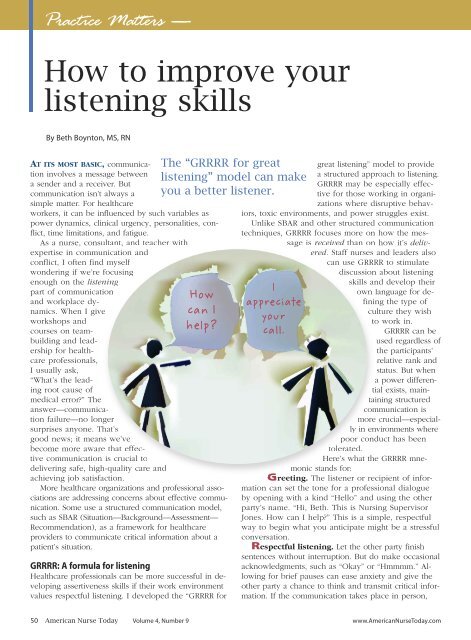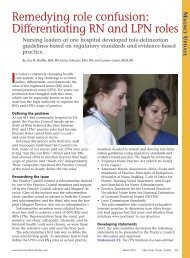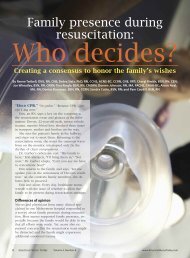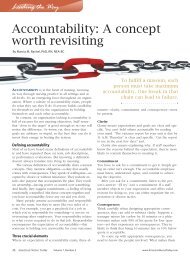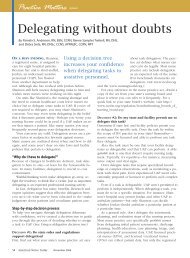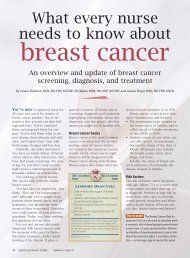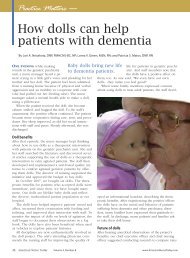How to improve your listening skills - American Nurse Today
How to improve your listening skills - American Nurse Today
How to improve your listening skills - American Nurse Today
You also want an ePaper? Increase the reach of your titles
YUMPU automatically turns print PDFs into web optimized ePapers that Google loves.
Practice Matters —<br />
<strong>How</strong> <strong>to</strong> <strong>improve</strong> <strong>your</strong><br />
<strong>listening</strong> <strong>skills</strong><br />
By Beth Boyn<strong>to</strong>n, MS, RN<br />
AT ITS MOST BASIC, communication<br />
involves a message between<br />
a sender and a receiver. But<br />
communication isn’t always a<br />
simple matter. For healthcare<br />
workers, it can be influenced by such variables as<br />
power dynamics, clinical urgency, personalities, conflict,<br />
time limitations, and fatigue.<br />
As a nurse, consultant, and teacher with<br />
expertise in communication and<br />
conflict, I often find myself<br />
wondering if we’re focusing<br />
enough on the <strong>listening</strong><br />
part of communication<br />
and workplace dynamics.<br />
When I give<br />
workshops and<br />
courses on teambuilding<br />
and leadership<br />
for healthcare<br />
professionals,<br />
I usually ask,<br />
“What’s the leading<br />
root cause of<br />
medical error?” The<br />
answer—communication<br />
failure—no longer<br />
surprises anyone. That’s<br />
good news; it means we’ve<br />
become more aware that effective<br />
communication is crucial <strong>to</strong><br />
delivering safe, high-quality care and<br />
achieving job satisfaction.<br />
More healthcare organizations and professional associations<br />
are addressing concerns about effective communication.<br />
Some use a structured communication model,<br />
such as SBAR (Situation—Background—Assessment—<br />
Recommendation), as a framework for healthcare<br />
providers <strong>to</strong> communicate critical information about a<br />
patient’s situation.<br />
GRRRR: A formula for <strong>listening</strong><br />
Healthcare professionals can be more successful in developing<br />
assertiveness <strong>skills</strong> if their work environment<br />
values respectful <strong>listening</strong>. I developed the “GRRRR for<br />
The “GRRRR for great<br />
<strong>listening</strong>” model can make<br />
you a better listener.<br />
<strong>How</strong><br />
can I<br />
help ?<br />
great <strong>listening</strong>” model <strong>to</strong> provide<br />
a structured approach <strong>to</strong> <strong>listening</strong>.<br />
GRRRR may be especially effective<br />
for those working in organizations<br />
where disruptive behaviors,<br />
<strong>to</strong>xic environments, and power struggles exist.<br />
Unlike SBAR and other structured communication<br />
techniques, GRRRR focuses more on how the message<br />
is received than on how it’s delivered.<br />
Staff nurses and leaders also<br />
can use GRRRR <strong>to</strong> stimulate<br />
discussion about <strong>listening</strong><br />
I<br />
appreciate<br />
<strong>your</strong><br />
call.<br />
<strong>skills</strong> and develop their<br />
own language for defining<br />
the type of<br />
culture they wish<br />
<strong>to</strong> work in.<br />
GRRRR can be<br />
used regardless of<br />
the participants’<br />
relative rank and<br />
status. But when<br />
a power differential<br />
exists, maintaining<br />
structured<br />
communication is<br />
more crucial—especially<br />
in environments where<br />
poor conduct has been<br />
<strong>to</strong>lerated.<br />
Here’s what the GRRRR mnemonic<br />
stands for:<br />
Greeting. The listener or recipient of information<br />
can set the <strong>to</strong>ne for a professional dialogue<br />
by opening with a kind “Hello” and using the other<br />
party’s name. “Hi, Beth. This is Nursing Supervisor<br />
Jones. <strong>How</strong> can I help?” This is a simple, respectful<br />
way <strong>to</strong> begin what you anticipate might be a stressful<br />
conversation.<br />
Respectful <strong>listening</strong>. Let the other party finish<br />
sentences without interruption. But do make occasional<br />
acknowledgments, such as “Okay” or “Hmmmm.” Allowing<br />
for brief pauses can ease anxiety and give the<br />
other party a chance <strong>to</strong> think and transmit critical information.<br />
If the communication takes place in person,<br />
50 <strong>American</strong> <strong>Nurse</strong> <strong>Today</strong> Volume 4, Number 9 www.<strong>American</strong><strong>Nurse</strong><strong>Today</strong>.com
make eye contact, nod, and use other<br />
receptive body language <strong>to</strong> promote<br />
rapport—even in the middle of an<br />
emergency. (See Seven tips for better<br />
<strong>listening</strong> <strong>skills</strong>.)<br />
Review. Summarize the information<br />
the speaker has conveyed <strong>to</strong> indicate<br />
you unders<strong>to</strong>od the message<br />
correctly, and <strong>to</strong> give the speaker the<br />
chance <strong>to</strong> correct any misunderstanding.<br />
Called validating, this technique<br />
allows you <strong>to</strong> clarify <strong>your</strong> concerns<br />
and express additional thoughts without<br />
being intimidating or humiliating.<br />
A few seconds of validation can help<br />
the speaker feel he or she has been<br />
heard, respected, and ultimately unders<strong>to</strong>od.<br />
<strong>How</strong>ever, this process can be challenging<br />
because it requires listeners<br />
<strong>to</strong> separate their perspective and response<br />
from those of the speaker.<br />
The ability <strong>to</strong> do this effectively can<br />
be influenced by such variables as<br />
time, stress, tradition, skill, training,<br />
mood—and even the weather!<br />
Doesn’t it seem prudent <strong>to</strong> establish<br />
an organizational norm for effective<br />
communication rather than try <strong>to</strong><br />
work around these variables?<br />
Recommend or request more<br />
information. Once the speaker is<br />
finished conveying his or her report<br />
and you’ve validated or clarified it,<br />
you have enough information <strong>to</strong><br />
make recommendations or request<br />
more information. Even if you disagree<br />
with the speaker’s message, be<br />
Seven tips for better <strong>listening</strong> <strong>skills</strong><br />
Follow the guidelines below <strong>to</strong> build <strong>your</strong> <strong>listening</strong> <strong>skills</strong>, assess <strong>your</strong> current<br />
<strong>listening</strong> <strong>skills</strong>, and facilitate conversations with colleagues about effective<br />
<strong>listening</strong>.<br />
1. Maximize <strong>your</strong> openness <strong>to</strong> other perspectives. Realize that seeing other<br />
viewpoints can add <strong>to</strong> <strong>your</strong> understanding—but keep in mind that you don’t<br />
have <strong>to</strong> change <strong>your</strong> perspective.<br />
2. Stay in the present. Use “centering” or another technique that helps you stay<br />
calm and focused.<br />
3. Keep <strong>your</strong> body language and vocal <strong>to</strong>ne receptive. Roughly 80% <strong>to</strong> 90%<br />
of communication is nonverbal. When nonverbal cues are aligned with the<br />
speaker’s words and intent, they can build trust. When they’re not aligned,<br />
mixed messages and broken trust may result. Keep in mind that body<br />
language and vocal <strong>to</strong>ne can be misunders<strong>to</strong>od. For example, folding <strong>your</strong><br />
arms across <strong>your</strong> chest may be interpreted as a sign of resistance when it may<br />
actually be an effort <strong>to</strong> conserve heat, cover up a stain, or support a sore arm.<br />
4. Demonstrate curiosity. Ask questions <strong>to</strong> seek better understanding. Clarify,<br />
paraphrase, and reflect on what the speaker has said. Think of the situation as<br />
an opportunity <strong>to</strong> learn.<br />
5. Validate. Show the speaker you are <strong>listening</strong> and understand what she or he<br />
is saying. Validating values the other person. Strive <strong>to</strong> make it a separate<br />
phase of the communication.<br />
6. Be aware of extenuating circumstances. For instance, the listener may be in<br />
the middle of a clinical emergency, late for an important meeting, or feeling<br />
ill. Or persons who shouldn’t be involved in or exposed <strong>to</strong> the exchange may<br />
be nearby, making privacy and confidentiality impossible. If it’s not a good<br />
time or place for the conversation <strong>to</strong> take place, let the other person know<br />
and suggest an alternative. Work <strong>to</strong> minimize distractions and interruptions,<br />
<strong>to</strong>o. If these are unavoidable, acknowledge their impact on <strong>your</strong> ability <strong>to</strong><br />
listen.<br />
7. Practice <strong>your</strong> <strong>listening</strong> <strong>skills</strong>. Accept that developing good <strong>listening</strong> <strong>skills</strong> is<br />
an ongoing process, and that <strong>listening</strong> well is harder on some days than<br />
others. Role-model good <strong>listening</strong> every chance you get. And give <strong>your</strong>self<br />
credit—<strong>listening</strong> well is hard work!<br />
sure <strong>to</strong> maintain a collaborative approach and avoid<br />
put-downs.<br />
The following response is collaborative: “A chest<br />
tube is a reasonable suggestion, and the objective information<br />
you’ve provided is great. This patient has<br />
some heart failure, <strong>to</strong>o, and that could be part of the<br />
problem. Let’s do a chest X-ray and ABGs stat. Take a<br />
minute and get those tests ordered. Then let’s review<br />
her med list.”<br />
Compare that with this combative response: “You’re<br />
wasting my time. Just get the chest X-ray and ABGs.”<br />
Reward. Rewarding the speaker for the information<br />
conveyed helps that person feel like a respected team<br />
player. For example, after <strong>listening</strong> <strong>to</strong> the speaker, you<br />
might say, “Thank you for <strong>your</strong> attention <strong>to</strong> this patient’s<br />
needs” or “I appreciate <strong>your</strong> call.” Inviting further<br />
discussion—for instance, “Call me if problems persist”—is<br />
an empowering strategy that reduces reluctance<br />
<strong>to</strong> call again in the future, thereby promoting a<br />
collaborative problem-solving environment.<br />
Addressing communication problems in healthcare<br />
settings gives leaders opportunities <strong>to</strong> teach about and<br />
build healthy work relationships by incorporating respectful<br />
<strong>listening</strong> in<strong>to</strong> communication training and<br />
workplace policies. As they do this, they can help colleagues<br />
steer clear of difficult dynamics and shift <strong>to</strong>wards<br />
collaboration.<br />
✯<br />
Beth Boyn<strong>to</strong>n is an organizational development consultant and author of the<br />
book, Confident Voices: The <strong>Nurse</strong>s’ Guide <strong>to</strong> Improving Communication & Creating<br />
Positive Workplaces. She is an adjunct faculty member at New England College and<br />
publishes the free e-newsletter Confident Voices for <strong>Nurse</strong>s. A featured columnist<br />
for ANA Maine Journal, Ms. Boyn<strong>to</strong>n has published numerous articles and offers<br />
various workshops. She can be reached at bbbboyn<strong>to</strong>n@earthlink.net. For more<br />
information, visit bethboyn<strong>to</strong>n.com.<br />
www.<strong>American</strong><strong>Nurse</strong><strong>Today</strong>.com November/December 2009 <strong>American</strong> <strong>Nurse</strong> <strong>Today</strong> 51


